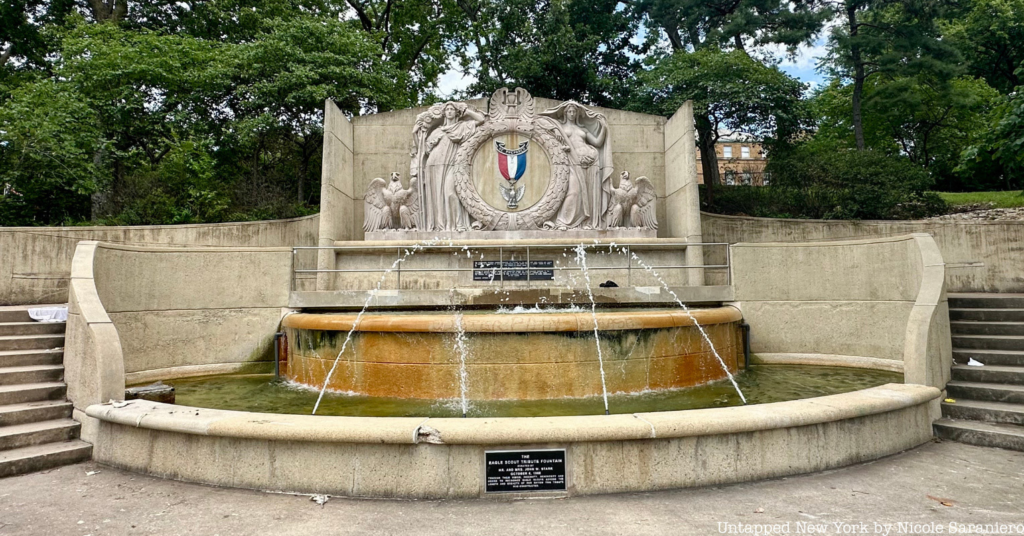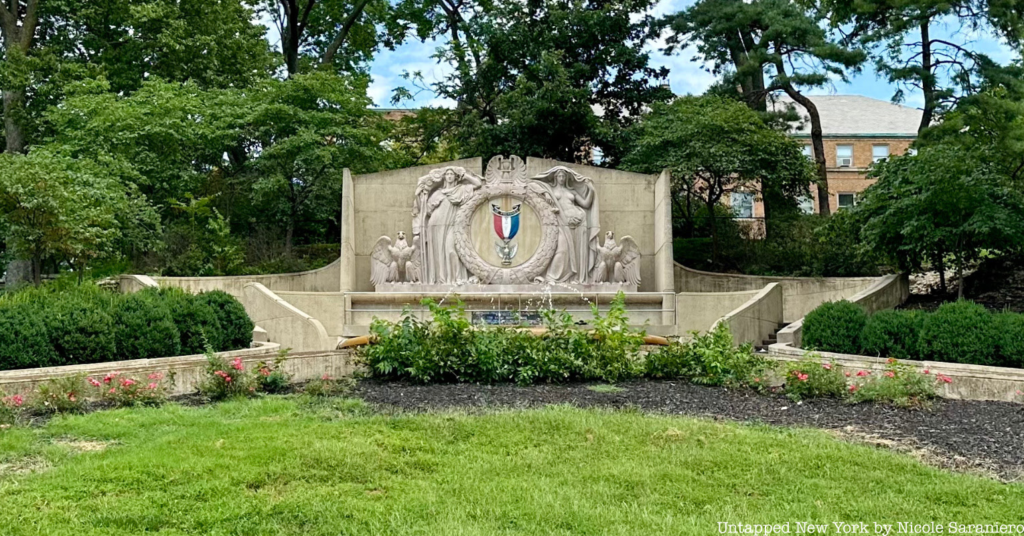Friday, September 6, 2024 – HOW DID THIS MASTERPIECE END UP IN KANSAS CITY?


This Fountain in Kansas City
Contains a Remnant
of
NYC’s Penn Station
ISSUE # 1301
UNTAPPED NEW YORK
Ever since I visited Kansa City in 2017, when I saw this fountain I have been curious about it traveled
from Pennsylvania Station to Kansas City. Here is the answer.

Before this sculpture became part of an Eagle Scout memorial in Missouri, it hung above the Seventh Avenue entrance to the original Pennsylvania Station in Manhattan. The colossal train station designed by the illustrious architecture firm of McKim, Mead, and White opened in 1910, welcoming the first LIRR train on September 2nd. When the station was infamously demolished in the 1960s, some ornamental pieces of the structure were salvaged. Stone eagles that sat atop the station’s cornice were spread throughout the northeast, St. John the Divine acquired lampposts that still sit in the cathedral’s basement, and this sculpture traveled halfway across the country.

German-American sculptor Adolph Alexander Weinman created the pink Milford granite sculpture at the center of the Kansas City Eagle Scout fountain. It features two female figures leaning on opposite sides of a central wreath that once encircled a 7-foot wide clock. The allegorical women are meant to represent Day and Night. While the figure on the left (Day) is adorned with sunflowers, the figure on the right (Night) is shrouded under a cloak. Both figures have an eagle at their feet.

Weinman created four pairs of Day and Night sculptures for Penn Station. When the station was demolished, the sculptures and clocks met various fates. The clocks were disposed of in the Meadowlands of New Jersey along with other debris from the demolition. Some fragments of the female figures and a couple of eagles turned up at a New Jersey Transit facility in Newark a few years ago and one Night figure is stored safely in the collection of the Brooklyn Museum.

So how did this sculpture end up in Kansas City? When news of Penn Station’s impending demolition was announced, John W. Starr, chairman of the Eagle Scout tribute committee, thought the entablature would make for the perfect Eagle Scout memorial in his hometown. According to a Kansas City Times article from 1968, the Kansas City area council awarded more Eagle Scout badges than anywhere else in the United States. Becoming an Eagle Scout is a rare feat that only a small percentage of Boy Scouts obtain. In 1966, the Pennsylvania Railroad gifted the statue to the Boy Scout organization.

The next hurdle was transporting the 62,000-pound piece over a thousand miles west. The Pennsylvania Railroad carried the sculpture to Saint Louis, its western terminus. It was then picked up by a flatcar on the Missouri Pacific Railroad for the rest of the journey to Kansas City. Finally, it was driven to a warehouse.
A few modifications were made to the original sculpture before it was unveiled in Missouri. In place of a central clock, an aluminum replica of an Eagle Scout badge was added to the middle of the wreath frame. The entire sculptural work was set atop a fountain designed by Maurice McMullen on land donated by The Kansas City Park and Recreation Department and the City of Kansas City. Starr raised the funds to pay for the design, construction, and landscaping. The fountain was dedicated on October 6, 1968.

You can now see the sculpture at the intersection of 39th Street and Gillham Road in Kansas City, but you don’t have to go all the way to Missouri to see remnants of Day and Night. An art installation by Andrew Leicester, titled Ghost Series, brought remnants of the original station into the modern transportation hub as bas-relief terra cotta murals. There are five murals in total scattered throughout the station. The Day and Night one can be found on the east end of the main LIRR concourse, near the 1,2,3 subway entrance. See this mural and more pieces of the original station on our upcoming Secrets of Penn Station and Moynihan Train Hall Tour!
CREDITS
UNTAPPED NEW YORK
PHOTO OF THE DAY
FULTON STREET, BROOKLYN
WHAT STORE DID THIS BECOME?
ROOSEVELTISLANDHISTORY@GMAIL.COM

EXCITING COMING ATTRACTION
100,000 plush flowers crafted by artist CJ Hendry will take over Four Freedoms Park from September 13-15! This immersive floral exhibition, Flower Market, is housed within a greenhouse built on the park’s lawn. Colorful florals inside were inspired by the Roosevelt family: the yellow Eleanor Roosevelt Rose, Tulips for the Roosevelt family’s Dutch heritage, red roses symbolizing the Roosevelt name, and Peonies, a signature flower of the family’s farm. Twelve original drawings by Hendry accompany the blossoming meadow. Visitors are encouraged to pluck their own flowers from the garden to take home. This exhibition is free and open to the public from 10am to 4pm on September 13 to 15.
Check out her website and imagine what we will see here:
https://cjhendrystudio.com
All image are copyrighted (c) Roosevelt Island Historical Society unless otherwise indicated
THIS PUBLICATION FUNDED BY DISCRETIONARY FUNDS FROM CITY COUNCIL MEMBER JULIE MENIN & ROOSEVELT ISLAND OPERATING CORPORATION PUBLIC PURPOSE FUNDS.


Copyright © 2024 Roosevelt Island Historical Society, All rights reserved.Our mailing address is:
rooseveltislandhistory@gmail.com

Leave a comment